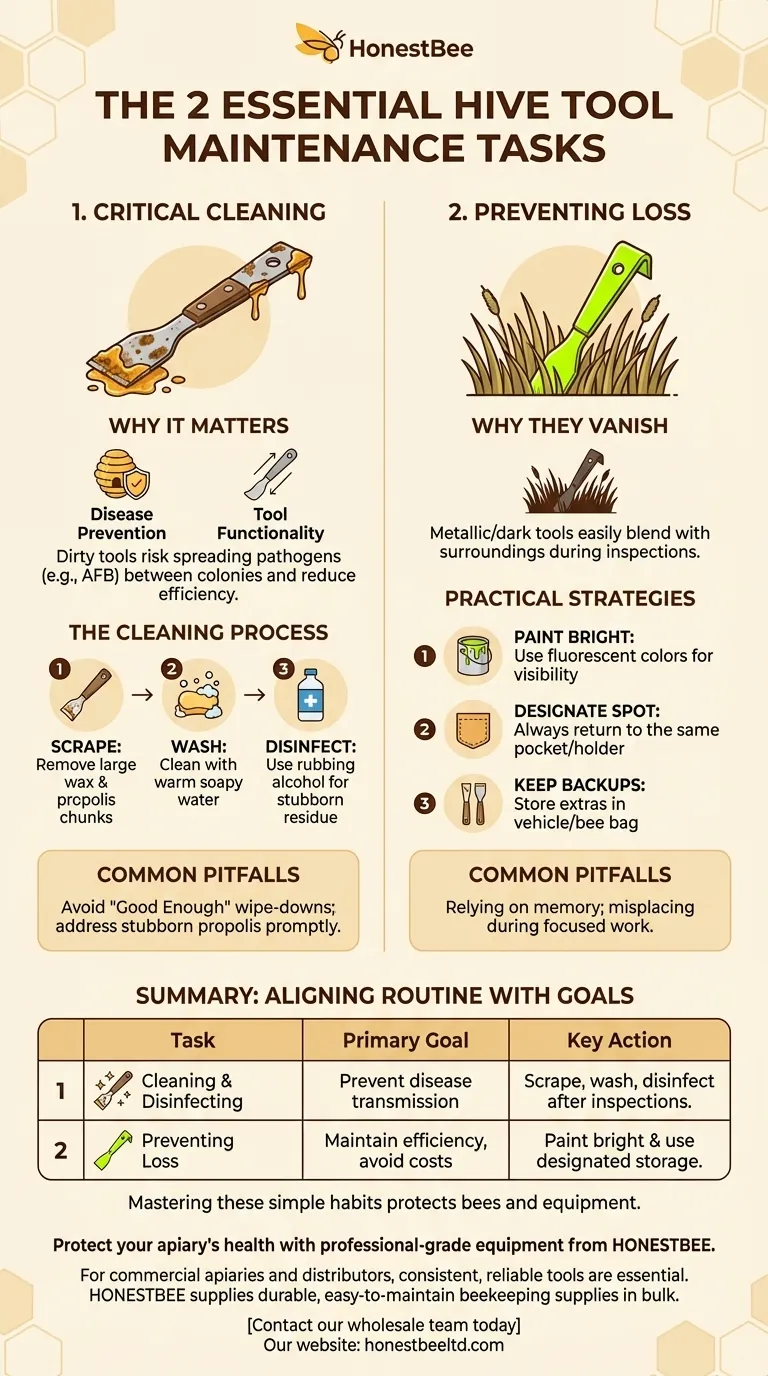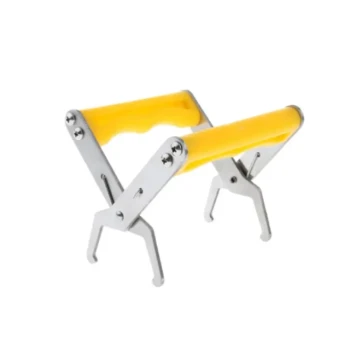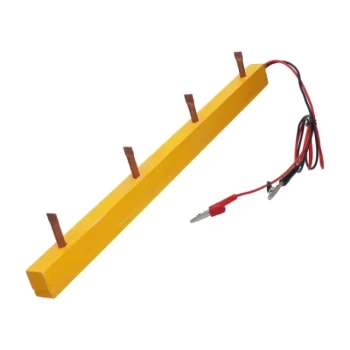The two primary maintenance tasks for any hive tool are keeping the tool meticulously clean and, just as importantly, developing a system so you don't lose it. While losing a tool is a common frustration, neglecting to clean it poses a direct threat to the health of your colonies.
Losing a hive tool is an inconvenience, but using a dirty one is a genuine risk. Proper, consistent cleaning is a non-negotiable step in beekeeping biosecurity, preventing the potential spread of disease from one hive to another.

The Critical Importance of Cleaning
A clean hive tool is not just about appearances; it's a cornerstone of responsible hive management. The sticky residues left behind after an inspection are more than just a nuisance.
Preventing Disease Transmission
Your hive tool comes into contact with every part of the hive interior, from honey and pollen to brood and propolis. If one colony has a pathogen, a dirty tool can easily transfer it to the next healthy colony you inspect.
This is especially critical for resilient diseases like American Foulbrood (AFB), whose spores can be spread mechanically on contaminated equipment.
Maintaining Tool Functionality
A tool caked in layers of old propolis and wax is less effective. The build-up makes it harder to slide between boxes, pry frames apart cleanly, and scrape away burr comb, increasing the physical effort required and the risk of jarring the bees.
A Simple Cleaning Process
Adopt a consistent cleaning routine after every inspection day.
First, scrape off any large chunks of wax or propolis. Then, wash the tool with warm, soapy water to remove honey residue. For stubborn, sticky propolis, use a rag with rubbing alcohol to dissolve it completely. Finally, dry the tool thoroughly to prevent rust.
The Universal Challenge of the Lost Tool
Beekeepers often joke that losing hive tools is as inevitable as getting stung. It's easy to set a tool down in the tall grass or leave it on top of a hive lid, only to realize it's gone hours later.
Why They Vanish
The standard metallic or dark color of most hive tools allows them to blend in perfectly with the ground, shadows, or equipment in an apiary. During the focused work of a hive inspection, it's easy to place it down absent-mindedly and forget where you left it.
Practical Strategies to Keep Your Tool
The best solution is to make your tool hard to lose. Many beekeepers paint the handle a bright, unnatural color like fluorescent pink or neon green, making it stand out instantly against any background.
Developing a strict habit is also effective. Designate a specific pocket or a magnetic holder on your hive stand where the tool lives when not in your hand. Owning a few and keeping them in your vehicle or bee bag also provides a crucial backup.
Common Pitfalls to Avoid
Even with the best intentions, it's easy to fall into habits that compromise your tool's effectiveness and your hive's safety.
The "Good Enough" Wipe-Down
Simply wiping the tool on your pant leg or a cloth between hives is not sufficient. This removes visible debris but does nothing to address microscopic pathogens. True cleaning requires washing or disinfecting.
Ignoring Stubborn Propolis
Letting propolis build up makes every future cleaning task harder. This "bee glue" hardens over time, requiring more force to remove and potentially damaging the tool's surface. Clean it off when it's still relatively fresh.
Making the Right Choice for Your Goal
Your maintenance routine should align with your beekeeping priorities.
- If your primary focus is hive health and biosecurity: Make cleaning and disinfecting your tool after inspecting each individual colony your top priority.
- If your primary focus is efficiency and convenience: Paint your tools a bright color and create a strict habit of returning them to the same pocket or toolbox immediately after use.
By mastering these two simple habits, you protect the health of your bees and the longevity of your equipment.
Summary Table:
| Maintenance Task | Primary Goal | Key Action |
|---|---|---|
| Cleaning & Disinfecting | Prevent disease transmission between hives | Scrape, wash with soapy water, and disinfect with rubbing alcohol after inspections. |
| Preventing Loss | Maintain efficiency and avoid replacement costs | Paint tools a bright color and develop a strict habit of storing them in a designated spot. |
Protect your apiary's health and your bottom line with professional-grade equipment from HONESTBEE.
For commercial apiaries and distributors, consistent, reliable tools are essential for efficient operations and biosecurity. HONESTBEE supplies durable, easy-to-maintain beekeeping supplies and equipment in bulk, helping you minimize downtime and maximize productivity.
Contact our wholesale team today to discuss your equipment needs and see how we can support your business.
Visual Guide

Related Products
- Ergonomic Two Person Foldable Hive Lifter
- Ergonomic High Visibility Plastic Frame Grip Handles
- Wooden Bee Brush with Triple Row Artificial Fiber for Beekeeping
- Professional Stainless Steel Frame Cleaner with Ergonomic Wood Handle
- Wooden Bee Brush with Double-Row Horsehair Bristles
People Also Ask
- How close can I put a beehive to my house? A Guide to Safe & Responsible Hive Placement
- When not to open a beehive? Protect Your Hive's Health by Avoiding These Critical Mistakes
- What precautions should be taken when using a sharpened hive tool? Maximize Efficiency While Staying Safe
- What is a beekeeper tool? The Essential Hive Management Lever for Apiaries
- What factors determine the size of a hive? Master the 3 Key Elements for Healthy Colonies



















